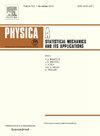Fundamental comparison between the pseudopotential and the free energy lattice Boltzmann methods
IF 2.8
3区 物理与天体物理
Q2 PHYSICS, MULTIDISCIPLINARY
Physica A: Statistical Mechanics and its Applications
Pub Date : 2025-01-16
DOI:10.1016/j.physa.2025.130374
引用次数: 0
Abstract
The pseudopotential and free energy models are two popular extensions of the lattice Boltzmann method for multiphase flows. Until now, they have been developed apart from each other in the literature. However, important questions about whether each method performs better needs to be solved. In this work, we perform a fundamental comparison between both methods through basic numerical tests. This comparison is only possible because we developed a novel approach for controlling the interface thickness in the pseudopotential method independently on the equation of state. In this way, it is possible to compare both methods maintaining the same equilibrium densities, interface thickness, surface tension and equation of state parameters. The well-balanced approach was selected to represent the free energy. We found that the free energy one is more practical to use, as it is not necessary to carry out previous simulations to determine simulation parameters (interface thickness, surface tension, etc.). In addition, the tests proofed that the free energy model is more accurate than the pseudopotential model. Furthermore, the pseudopotential method suffers from a lack of thermodynamic consistency even when applying the corrections proposed in the literature. On the other hand, for both static and dynamic tests we verified that the pseudopotential method was able to simulate lower reduced temperature than the free energy one. We hope that these results will guide authors in the use of each method.
求助全文
约1分钟内获得全文
求助全文
来源期刊
CiteScore
7.20
自引率
9.10%
发文量
852
审稿时长
6.6 months
期刊介绍:
Physica A: Statistical Mechanics and its Applications
Recognized by the European Physical Society
Physica A publishes research in the field of statistical mechanics and its applications.
Statistical mechanics sets out to explain the behaviour of macroscopic systems by studying the statistical properties of their microscopic constituents.
Applications of the techniques of statistical mechanics are widespread, and include: applications to physical systems such as solids, liquids and gases; applications to chemical and biological systems (colloids, interfaces, complex fluids, polymers and biopolymers, cell physics); and other interdisciplinary applications to for instance biological, economical and sociological systems.

 求助内容:
求助内容: 应助结果提醒方式:
应助结果提醒方式:


